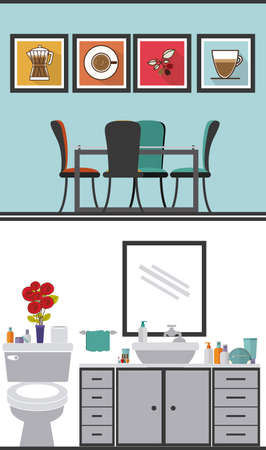Understanding Indian Climate and Its Impact on Bathroom Materials
Indias vast landscape encompasses a remarkable diversity of climates, from the sultry humidity of Kerala and Mumbai to the arid dryness of Rajasthan and the fluctuating temperatures of northern states like Delhi and Punjab. This wide range of weather conditions plays a crucial role in determining which bathroom remodeling materials will endure over time. In humid regions, persistent moisture can lead to mold growth, corrosion, and premature wear if unsuitable materials are chosen. Conversely, in dry or extremely hot areas, certain materials may crack or lose their finish due to lack of humidity and intense heat. Recognising these regional climate challenges is essential for Indian homeowners looking to remodel their bathrooms with long-lasting results. The right material selection not only ensures durability but also helps in maintaining hygiene, minimising maintenance efforts, and preserving aesthetics despite the climatic extremes. Hence, understanding how Indias unique climate zones influence the performance and longevity of bathroom materials is the first step towards making informed remodeling choices tailored to local conditions.
2. Moisture-Resistant Flooring Options
When it comes to bathroom remodeling in India, selecting the right flooring material is crucial due to the country’s humid and moisture-laden climate. Indian bathrooms often experience high levels of water exposure from daily bathing routines, making moisture resistance a top priority. Below, we discuss some of the most popular and locally available flooring materials that are well-suited for Indian conditions.
Anti-Skid Tiles: Safety Meets Durability
Anti-skid tiles are widely preferred across Indian households for bathroom floors. These tiles are specially designed with textured surfaces that prevent slips and falls—a common concern in wet environments. Available in a variety of colours, patterns, and sizes, anti-skid tiles blend safety with style, making them an excellent choice for families with children or elderly members.
Vitrified Tiles: Low Maintenance & High Strength
Vitrified tiles have gained immense popularity for their dense structure, low porosity, and resistance to stains and moisture. They are also easy to clean, which is highly valued in Indian homes where water splashes and soap residue are frequent issues. Vitrified tiles come in both glossy and matte finishes, catering to different aesthetic preferences while ensuring longevity even in heavy-use bathrooms.
Natural Stones: Timeless Elegance with Robustness
Materials like granite, slate, and kota stone are traditional favourites in India due to their natural beauty and robustness. While these stones add a touch of luxury, it is essential to ensure proper sealing during installation to prevent water absorption and fungal growth—especially important in coastal or high-humidity regions. Natural stones tend to keep the floor cool during hot summers, an added advantage for tropical climates.
Comparison Table: Popular Bathroom Flooring Materials
| Material | Moisture Resistance | Slip Resistance | Maintenance | Local Availability |
|---|---|---|---|---|
| Anti-Skid Tiles | High | Excellent | Low | Very Good |
| Vitrified Tiles | Very High | Good (Matte Finish) | Very Low | Excellent |
| Kota Stone/Granite/Slate | Moderate (with sealing) | Good (when textured) | Medium (requires periodic sealing) | Good (region dependent) |
Expert Tip:
For best results in Indian bathrooms, combine anti-skid vitrified tiles for the main floor area with natural stone accents near dry zones. Always opt for professional installation to ensure proper drainage and sealing, extending the life of your chosen material.

3. Wall Materials that Withstand Humidity and Heat
When considering bathroom remodeling in India, it is vital to choose wall materials that can withstand the country’s unique climatic conditions—ranging from intense humidity in coastal areas to high temperatures in interior regions. The right wall cladding not only enhances aesthetics but also ensures long-term durability and ease of maintenance.
Ceramic Tiles: Timeless and Resilient
Ceramic tiles are a classic choice for Indian bathrooms due to their excellent resistance to moisture, heat, and stains. They are available in a wide array of patterns, colours, and textures to match any décor style, from traditional to contemporary. Their non-porous nature prevents water seepage, making them ideal for regions with heavy monsoons or persistent humidity. Easy to clean and maintain, ceramic tiles remain a favourite among Indian homeowners.
PVC Wall Panels: Modern and Waterproof
PVC (polyvinyl chloride) panels have gained popularity as a modern wall cladding solution, especially suited for the Indian climate. Lightweight yet sturdy, these panels are 100% waterproof, resistant to mould and mildew, and can be installed quickly without extensive masonry work. PVC panels offer a sleek finish and are available in various designs that mimic wood, stone, or marble—making them a practical choice for both urban apartments and suburban homes.
Waterproof Paints: Protection Beyond Looks
For those who prefer painted walls over tiles or panels, investing in high-quality waterproof paints is essential. These specialised paints form a protective barrier against moisture ingress and fungal growth—an important consideration for Indian bathrooms exposed to frequent temperature fluctuations. Opting for brands that specifically market “bathroom” or “weatherproof” variants ensures greater longevity and vibrancy of wall colours.
Choosing the Right Material for Your Region
Whether you live in humid Kerala, hot Rajasthan, or the cooler hills of Himachal Pradesh, selecting the appropriate wall material is key. Ceramic tiles perform well across all zones, while PVC panels are particularly effective in damp environments like coastal cities. Waterproof paints can be an economical option for dry zones but should always be paired with good ventilation and anti-fungal primers for best results.
Conclusion: Invest in Quality for Lasting Comfort
The right combination of ceramic tiles, PVC panels, or advanced waterproof paints will shield your bathroom walls from India’s diverse climate challenges while keeping your space stylish and easy to maintain. Always consult local suppliers familiar with regional weather patterns to make informed choices tailored to your specific needs.
4. Choosing the Right Sanitaryware and Fixtures
When it comes to bathroom remodeling in India, selecting sanitaryware and fixtures that can withstand the local climate and water conditions is crucial. Indian households often face challenges like hard water, high humidity, and frequent usage, which can cause wear and tear over time. Therefore, opting for durable and easy-to-clean fittings becomes essential for long-lasting performance and hassle-free maintenance.
Why Stainless Steel and Brass Are Ideal Choices
Stainless steel and brass are highly recommended materials for bathroom fixtures in Indian homes. These metals offer exceptional resistance to corrosion, rust, and mineral deposits caused by hard water. Moreover, their smooth surfaces make cleaning simple, helping you maintain hygiene effortlessly. Both materials also blend well with modern as well as traditional Indian bathroom aesthetics.
Comparing Fixture Materials for Indian Bathrooms
| Material | Durability | Ease of Cleaning | Suitability for Hard Water |
|---|---|---|---|
| Stainless Steel | Excellent | Very Easy | Highly Suitable |
| Brass | Very Good | Easy | Highly Suitable |
| Plastic (PVC) | Moderate | Easy | Not Recommended |
| Ceramic-Coated | Good | Moderate | Prone to Stains from Hard Water |
Taps, Showers, and Flush Systems: What to Choose?
Select taps and showerheads made from stainless steel or brass for longevity. For flush systems, look for dual-flush mechanisms with anti-corrosive components to save water while ensuring reliability. These features are particularly helpful in Indian cities where water conservation is a priority and municipal supply can be inconsistent.
Cultural Preferences and Practicality
Indian bathrooms often have both Western-style commodes and traditional Indian toilets (squat pans). Ensure that your chosen fixtures cater to your familys preferences while prioritising durability. Investing in branded sanitaryware not only ensures better after-sales service but also guarantees quality suited for Indian climatic challenges.
5. Ventilation Solutions for Indian Bathrooms
In the context of Indian climate, where humidity and temperature variations are common, proper ventilation is a critical aspect of bathroom remodeling. Without adequate air circulation, bathrooms can become breeding grounds for mould, mildew, and persistent odours, compromising both hygiene and comfort.
Exhaust Fans: Essential for Moisture Control
Installing high-quality exhaust fans is one of the most effective ways to expel moist air after showers or cleaning activities. Opt for energy-efficient models with sufficient capacity (measured in CFM) suitable for your bathroom’s size. In Indian households, exhaust fans are especially vital during monsoon seasons when humidity levels soar.
Louvre Windows: Combining Privacy with Airflow
Louvre windows, also known as jalousie windows, are widely appreciated in India for their ability to facilitate cross-ventilation while maintaining privacy. These adjustable slats allow you to control airflow without fully exposing the interior space. Choose materials like UPVC or powder-coated aluminium for durability against weather changes.
Natural Airflow: Traditional Yet Effective
Many Indian homes benefit from architectural designs that encourage natural airflow. Positioning windows strategically—preferably on opposite walls—promotes cross-ventilation, which helps in keeping the bathroom dry and fresh naturally. For homes with limited window options, consider ventilator openings near the ceiling to allow hot, humid air to escape.
Maintaining Hygiene and Preventing Mould
Proper ventilation not only curbs moisture build-up but also deters bacterial growth and maintains overall hygiene standards. Regular cleaning of vents and fan grills ensures optimal performance. By integrating efficient exhaust fans, louvre windows, and traditional airflow techniques, you can create a healthy and comfortable bathroom environment perfectly suited for the diverse Indian climate.
6. Cost-Effective and Sustainable Material Choices
When selecting bathroom remodeling materials for Indian homes, balancing affordability with sustainability is crucial. The Indian climate—with its monsoons, humidity, and temperature fluctuations—demands resilient materials that won’t strain your budget. One excellent approach is to consider locally sourced options such as terracotta tiles. Terracotta not only adds a rustic, earthy aesthetic but also offers natural cooling properties ideal for hot and humid regions. Its production supports local artisans and reduces transportation emissions, making it an eco-friendly choice.
Another smart option is incorporating recycled materials into your bathroom design. Recycled glass tiles, reclaimed wood vanities, or upcycled metal fixtures are gaining popularity in urban Indian homes due to their unique look and minimal environmental impact. These materials withstand moisture well and often come at a lower cost compared to imported alternatives.
For those looking to optimise both cost and climate resilience, composite materials made from natural fibres and resins can be highly effective. They mimic the appearance of stone or wood while offering increased durability against water exposure—a common issue during the monsoon season. Furthermore, these composites are generally more budget-friendly than their natural counterparts and require less maintenance over time.
It’s essential to choose sealants and adhesives that are low in VOCs (Volatile Organic Compounds) to ensure healthy indoor air quality. Many Indian brands now offer affordable eco-friendly products tailored for tropical conditions, helping you stay within budget without compromising on environmental responsibility.
In summary, opting for sustainable choices such as terracotta, recycled elements, and locally produced composite materials aligns with both economic considerations and the need for climate-adapted solutions. This mindful selection not only enhances your bathroom’s longevity but also contributes positively to the environment and local economy.
7. Maintenance Tips for Longevity
Ensuring the durability and freshness of your bathroom remodeling materials in the Indian climate requires a proactive approach to maintenance. The combination of high humidity, hard water, and frequent temperature changes can take a toll on even the most robust materials. Here are some practical tips to keep your bathroom looking and functioning at its best:
Regular Cleaning Routine
Establish a consistent cleaning schedule using mild, pH-neutral cleaners. Avoid harsh chemicals that can damage tiles, natural stone, or fixtures. For tiles and grout, use a soft brush to prevent dirt buildup, which is common in humid conditions.
Combat Hard Water Stains
Hard water is prevalent across many parts of India and often leaves unsightly stains on faucets, glass partitions, and tiles. Wipe surfaces dry after each use and clean with a solution of vinegar and water weekly to dissolve mineral deposits. Consider installing a water softener if hard water is a persistent issue in your area.
Ventilation Is Key
Proper ventilation helps prevent mould and mildew growth, especially during monsoons. Ensure exhaust fans are functional and windows are kept open whenever possible. For windowless bathrooms, consider installing a dehumidifier or using moisture-absorbing products.
Protect Wooden Elements
If you have incorporated engineered wood or waterproof plywood, periodically apply a protective sealant suited for Indian weather conditions. Immediately wipe away any standing water to avoid swelling or warping of wooden surfaces.
Seal Grout Lines
Grout lines are particularly vulnerable in the Indian climate due to moisture exposure. Apply a high-quality grout sealer annually to prevent cracking and discoloration. Regular inspection will help you address issues before they escalate.
Maintain Metal Fixtures
To preserve the shine of stainless steel or brass fittings, clean them with a mixture of mild soap and water. Dry thoroughly after each wash to prevent corrosion or tarnishing caused by humidity and salt in coastal regions.
Final Thought
A well-maintained bathroom not only enhances daily comfort but also adds long-term value to your home. By following these easy yet effective maintenance practices tailored for Indian conditions, you can ensure that your chosen materials remain fresh, hygienic, and fully functional for years to come.


